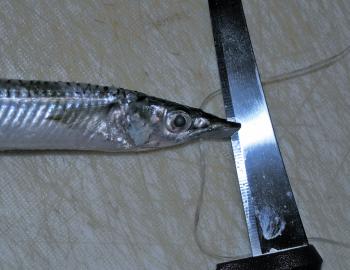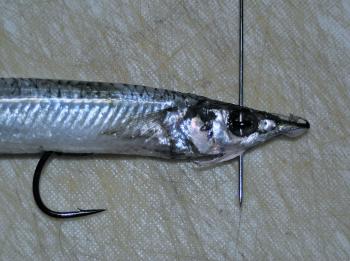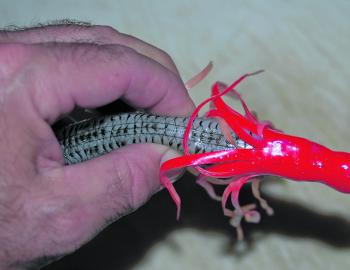With waters warming during spring, anglers will be entering the prime period to target one of the numerous billfish species, which grace our Southern Queensland waters.
The two main species on offer are sailfish and juvenile black marlin, many of which are less than 40kg in weight, making great light tackle targets for those fishing the inshore grounds off Brisbane, the Gold Coast and the Sunshine Coast. Although larger specimens are taken, the majority of anglers will only encounter these smaller billfish along with others such as mahimahi, tunas, Spanish mackerel and wahoo. While lures will take all these species, billfish in particular will respond exceptionally well to trolled baits. One of the more popular offerings, due to its simple rigging and high productivity is the skipping garfish.
Sailfish in particular are more commonly caught on trolled baits than lures. In fact, I would reckon you will catch ten sailfish on trolled natural baits to every one you convert on lures. Black marlin are also often more responsive to trolled baits than lures so it goes to reason that knowing how to rig these offerings is an exceptionally good skill to have up your sleeve, especially for those times when the bite is slow. There are many different types of baits that can be rigged with most working exceptionally well on an array of predatory fish. However, the garfish is a good choice due to its flexibility, durability, ease of acquisition and productiveness. Let’s look at what you will need to rig a skipping gar, how to do this and an easy way to convert this bait into a swimming gar.
Quality gar can usually be acquired at tackle stores, bait shops and seafood shops or you could catch your own in the creeks and canals by berleying with bread crumbs and using a little bit of dough on a small hook suspended beneath a pencil float.
There are several hooks that can be used to rig baits with some of the more common ones being the Owner Longshank (available in 7/0, 9/0 and 11/0), Gamakatsu SL12S (usually 9/0 or 10/0) or Mustad 3407AD (usually in 8/0 or 9/0 but these can be a little hard to locate now). Any O’Shaughnessy (not offset) hook pattern can be used however. Traditionally we used needle-eye hooks but these are nearly impossible to find these days. If using one of the chemically sharpened hooks then add a little anode tape to minimise electrolysis and prolong the sharpness of the point.
Skipping garfish are simple to rig out on the boat although you can do these the day before your trip at home. If you acquire fresh garfish you can even rig them and cryovac for a future trip. Just defrost them and you are ready to go. Now is the time to get out amongst the sailfish, marlin and other prime predators on offer in SEQ.
There are several items you will require for this project once you have acquired some quality garfish. Leader material (monofilament or fluorocarbon, generally 60lb to 100lb), a sharp knife, a bait needle, bait rigging floss (dental floss will suffice), crimps for your leader, a swaging tool, mono cutters and a squid skirt (large enough to go over the garfish head). Additionally you may also want a bubble head to provide extra surface commotion or a Baitswimmer if you want to quickly convert your skipping gar into a swimming gar.
Steps
1
Position your hook alongside your garfish with the hook eye level with the garfish eye and then cut a small slit in the belly adjacent to the end of the hook shank (where the bend starts). Also cut the beak of the garfish, leaving only about 5mm protruding.
Tie a short length of bait rigging floss to the eye of your needle and then insert the needle centrally through the garfish head, a few millimetres in front of the eye.
2
Cut a small slot centrally in the remaining beak. This slot only needs to be a few millimetres deep to hold the bait rigging floss in place once secured.
3
Pull tight and knot the bait floss together so that you have secured the mouth of the garfish shut. Use the end of your needle to remove the garfish eyeballs. Push the hook (eye first) up through the gut slot you cut earlier and through the body until the hook eye is inside the eye socket. Next insert the needle centrally through the garfish head directly above the eye socket. It should pass through the hook eye and out through the chin of the bait.
4
Remove the needle out of the gar head. Place a crimp on your leader and then pass the leader through the hole left by the needle. Ensure the leader passes through the eye of the hook. Always double check that it has by tugging slightly on the hook.
5
Pull the leader material into a fairly tight loop around the nose of the bait as shown and then secure with a good squeeze of the swaging tool onto the crimp. Trim off the tag end of the leader fairly close to the crimp with your cutters.
6
Choose a squid skirt that fits snug over the head of the garfish. Pink or luminous green are extremely popular colours but you can use whatever colour you wish. Pierce a small hole in the centre of the nose of the squid skirt and then insert the other end of the leader through this. Slide the squid skirt down over the nose of the gar. In the free end of the leader, crimp a small loop or secure it to a solid ring. This will allow easy attachment to the snap swivel on your wind-on-leader.
7
Holding the garfish between your forefinger and thumb, squeeze firmly until you feel a small pop as the flesh breaks away from the vertebrae. Do this right along the length of the bait roughly level with the lateral line.
Flex the bait backwards and forwards in a snake like fashion to ensure it is now limp and supple. This will allow it to move more realistically as it slaps across the surface and will also be easier for a billfish to mouth and swallow. Your basic skip gar is now ready for action.
8
An addition to your basic skipping gar bait can be a bubble head. This adds extra splash and a slightly different action to the trolled bait. Several companies make these but the one seen here is a Moldcraft brand distributed by Black Pete Marine. It is best if the recessed side of the bubble head sits over the nose of the bait, especially in rougher conditions. (Note: a bubble head would need to be added before you crimp the loop or solid ring on the free end of the leader)
Reads: 11195











